
Sardinia is the second-largest island in the Mediterranean Sea, after Sicily, and one of the 20 regions of Italy. It is located west of the Italian Peninsula, north of Tunisia and immediately south of the French island of Corsica.

Algherese or Alguerese is the variant of Catalan spoken in the city of Alghero, in the northwest of Sardinia, Italy.
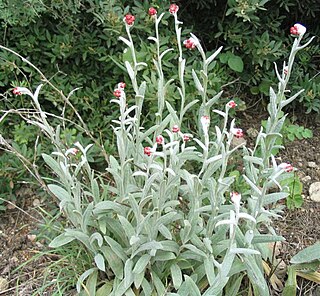
The genus Helichrysum consists of an estimated 600 species of flowering plants in the sunflower family (Asteraceae). The type species is Helichrysum orientale. They often go by the names everlasting, immortelle, and strawflower. The name is derived from the Greek words ἑλίσσω and χρῡσός.

The Gnaphalieae are a tribe of flowering plants in the family Asteraceae. It is most closely related to the tribes Anthemideae, Astereae, and Calenduleae.

The Punic religion, Carthaginian religion, or Western Phoenician religion in the western Mediterranean was a direct continuation of the Phoenician variety of the polytheistic ancient Canaanite religion. However, significant local differences developed over the centuries following the foundation of Carthage and other Punic communities elsewhere in North Africa, southern Spain, Sardinia, western Sicily, and Malta from the ninth century BC onward. After the conquest of these regions by the Roman empire in the third and second centuries BCE, Punic religious practices continued, surviving until the fourth century CE in some cases. As with most cultures of the ancient Mediterranean, Punic religion suffused their society and there was no stark distinction between religious and secular spheres. Sources on Punic religion are poor. There are no surviving literary sources and Punic religion is primarily reconstructed from inscriptions and archaeological evidence. An important sacred space in Punic religion appears to have been the large open air sanctuaries known as tophets in modern scholarship, in which urns containing the cremated bones of infants and animals were buried. There is a long-running scholarly debate about whether child sacrifice occurred at these locations, as suggested by Greco-Roman and biblical sources.
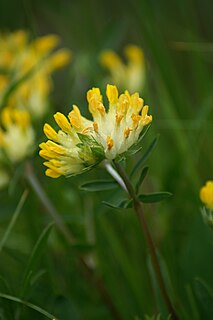
Anthyllis is a genus of flowering plants in the family Fabaceae. This genus contains both herbaceous and shrubby species and is distributed in Europe, the Middle East and North Africa. The most widespread and familiar species is A. vulneraria, a familiar grassland flower which has also been introduced to New Zealand.
José Ignacio "Iñaki" Sáez Ruiz is a Spanish former football player and manager.

Damien Saez or just Saez, is a French singer-songwriter and musician.

Oenanthotoxin is a toxin extracted from hemlock water-dropwort and other plants of the genus Oenanthe. It is a central nervous system poison, and acts as a noncompetitive antagonist of the neurotransmitter gamma-aminobutyric acid. A case has been made for the presence of this toxin in local Oenanthe species playing a causative role in euthanasia in ancient Sardinia. It was crystallized in 1949 by Clarke and co-workers. It is structurally closely related to the toxins cicutoxin and carotatoxin. Oenanthotoxin is a C17 polyacetylene isomer of cicutoxin.
Pentatrichia is a genus of African plants in the tribe Gnaphalieae within the family Asteraceae.

Brimeura is a genus of bulb-forming, monocotyledonous perennial plants. They have narrow leaves and bear bluebell-like flowers in Spring. Brimeura is treated in the family Asparagaceae, subfamily Scilloideae, tribe Hyacintheae, subtribe Hyacinthinae. It contains the following species

Helichrysum luteoalbum, the Jersey cudweed, is a species of flowering plant in the family Asteraceae.

The Kingdom of Sardinia, also referred to as the Kingdom ofSavoy-Sardinia, Piedmont-Sardinia, or Savoy-Piedmont-Sardinia during the Savoyard period, was a state in Southern Europe from the early 14th until the mid-19th century.
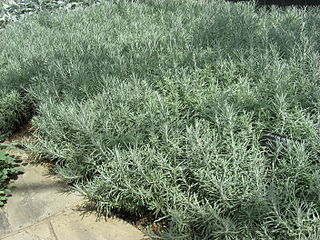
Helichrysum rupestre is a species of plant in the family Asteraceae.
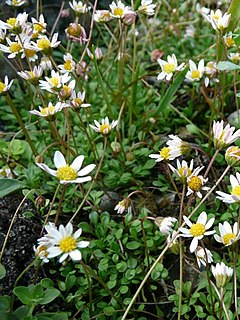
Bellium is a genus of flowering plants in the daisy family, Asteraceae, native to the Mediterranean region.
Bariadorgia is a white Italian/French wine grape variety that likely originated on the island of Sardinia but today is only found in limited planting on Corsica. Despite similarities in synonyms, Bariadorgia/Carcajolo blanc is not a color mutation of the red Spanish wine grape Parraleta which is also known as Carcajolo near on Sardinia.

Héctor Sáez Benito is a Spanish cyclist, who currently rides for UCI ProTeam Caja Rural–Seguros RGA. He was named in the startlist for the 2017 Vuelta a España.

Chungará is a lake situated in the extreme north of Chile at an elevation of 4,517 metres (14,820 ft), in the Altiplano of Arica y Parinacota Region in the Lauca National Park. It has a surface area of about 21.5–22.5 square kilometres (8.3–8.7 sq mi) and has a maximum depth of about 26–40 metres (85–131 ft). It receives inflow through the Río Chungara with some minor additional inflows, and loses most of its water to evaporation; seepage into the Laguna Quta Qutani plays a minor role.

NGC 810 is an unbarred elliptical galaxy located in the constellation Cetus, approximately 360 million light-years from the Milky Way. It was discovered by the French astronomer Édouard Stephan in 1871.
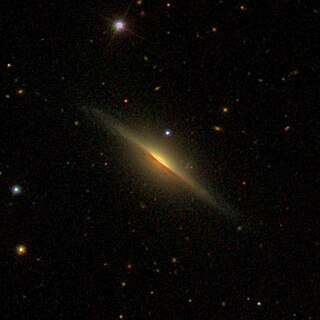
NGC 825 is an unbarred spiral galaxy in the constellation Cetus, estimated to be 154 million light-years away. The object was discovered by the astronomer Albert Marth on November 18, 1863.

















